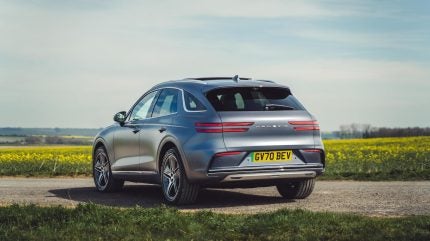
Recently, the Korean media got into a frenzy, claiming that HMG may be returning to Russia. The car market there is in turmoil, Chinese brands continue to attack but sales volume has collapsed, even for Lada. Long gone is the era of Kia and Hyundai being big players with Genesis a rising star. We know what happened in 2022.
It’s been four years since Hyundai brought the premium marque to the UK, Switzerland and Germany. Their combined volume keeps improving but remains modest. Nothing like how strong Genesis had been in Russia, a market which OEMs – Toyota is the best example – grouped as part of their European region.

Discover B2B Marketing That Performs
Combine business intelligence and editorial excellence to reach engaged professionals across 36 leading media platforms.
Now: GB, CH, DE; next: SE, NO, DK etc?
No-one on the recent British media preview of the updated Electrified GV70 would say anything about possible new markets. There again, the global boss himself denied that Genesis would enter Le Mans/Daytona/the World Endurance Championship when I asked him at the Goodwood Festival of Speed last year. Soon after, a statement out of Korea said the opposite: an entry for LMDh would be happening. Still, he did at least give me an exclusive about hybrid plans.
So. Who knows what is true and what isn’t when it comes to Genesis’ plans. It does seem highly likely that new countries will be announced. At a guess I would say the Nordics, France, The Netherlands; plus maybe Spain, Italy, others. Certainly, the range of models is now ideal: the facelifted GV60 and G80 revealed earlier in 2025 are due to arrive in the existing three European countries during Q3.
GV60, GV70 & G80: facelifts for all three
What we do know is that the GV60 remains electric-only worldwide, but non-EV versions of the updated GV70 are not coming to Britain. Nor will there be a right-hand drive G90, which is a shame but understandable. Despite how fantastic it looks, a six-figures Korean limo would be a hard sell in the UK.
We will have only a long-wheelbase Electrified G80 when the refreshed car lands here in July or August, the standard length body having been discontinued worldwide. Oh, and a reminder that the G70 and GV80 are no longer imported to Britain, meaning the once-big range of models is now more sensibly sized.
The factory-owned importer is far from discouraged by the pace of sales these last few years. In fact, even allowing for a sudden drop in April, 2025 has so far been a good year, Q1 deliveries being strong. Now with the Electrified GV70 revamp and two more refreshes following soon, momentum should build.
Why not just GV70 when it’s EV-only?
I put it to Brand Director Jonny Miller that surely Genesis UK could drop the Electrified part of the model names. In theory this would work, he could see, so that we have the GV60, GV70 and G80 but for now, the Electrified prefix stays (though the GV60 has never had that). And the pre-facelift model will be around for a while yet, as stocks of IC-powered variants were ordered for those prospective buyers who don’t want an EV, whatever the brand.
Changes to the car itself are more extensive than it seems via a casual glance. Even the diamond-pattern front panel, which is a grille in the petrol variants sold elsewhere, is fresh. And where you used to press a spring-loaded charging port cover to open it, this is now electric, and heated (snow). There is a pleasing whir as the covered sockets are revealed.
Interior even more luxurious than it had been
Headlights too are new, the same applies for the bumpers, the wheels are different designs, paint choices have also changed and the interior has had a big makeover. Sadly, the HVAC system is mostly screen-based but there are at least a couple of dials to twiddle and the software in general worked rapidly in the cars I drove.
There is a long OLED display atop the dashboard now, while three colour choices feature: black, white & blue or grey & brown. The second and third of those options look rather luxurious in fact even if those combinations may not sound as if they work. They do.
Speaking of luxury, Genesis operates a concierge-style service for owners, though the original We-Come-To-You approach is now expanding to bricks and mortar sales sites. Product Manager Robin Price claims this is “A five-star experience that respects your time, unlike any other car brand”. In fact, Genesis needs to collect and return an owner’s car when it needs a service or has a fault. Why? Because there have only ever been ‘Studios’, similar to the display spaces Polestar, Tesla and others operate in shopping malls.
A hybrid (or an EREV) to reach Europe in 2027?
Even though this brand had at one time declared that it would be electric-only by 2025, this plan was binned in 2024 as the world and laws on emissions keep evolving. Diesel engines for Genesis are also now in the past but one or more hybrids are in the future.
In the case of the JK1 series GV70, such a car will be in production towards the end of next year. Or so say sources in South Korea, the cypher for this derivative being JKa. The three-letters code gives the game away on where the hybrid will be manufactured: in HMG-speak, a lower case a signifies the United States. Ulsan will however remain as the lead plant.
Dating to 2020, the first generation GV70 will have an extended life, HMG brand models often living for a mere six years with a facelift three years in. A successor probably now won’t come until 2028, due to the adaptation of the present model’s chassis for a petrol-electric powertrain. Will this be a series hybrid or will it instead have a range extender? Nobody is saying.
Ten years of Genesis
It may look like a crossover but the Electrified GV70 is marketed as an SUV. It even has Snow/Mud/Sand settings and standard four-wheel drive. There is a way of making it mimic a V6 too, this being via an ‘Active Sounds’ function. Other than that, the two motors keep themselves near-silent, as befits any vehicle from what is a luxury make. And this year marks one decade since Genesis became a brand, evolving out of a Hyundai sedan’s name.
Another big change is the battery, formerly 77.4 kWh and now 84 kWh (net in both cases). This, we suspected would happen, due to certain Hyundai and Kia EVs gaining the same capacity pack of cells last year. I didn’t get to test the car for more than an hour or two, but did notice that 84% of remaining range equated to 240 miles. Or so the instrument cluster claimed. The WLTP rating is 298 miles.
Three trim levels, one battery, up to 360 kW
The model grades have also been refreshed, the new names being Pure (from GBP61,915 OTR before options), Dynamic (GBP70,715) and Luxury (GBP74,915). Each gets the CCIC or Connected Car Integrated Cockpit, Google Maps within the gauges cluster, entertainment streaming (the transmission must be in Park) and a B&O sound system.
This is quite a fast and powerful vehicle, combined outputs from the two 180 kW motors being 324 kW (440 PS) and 700 Nm (516 lb-ft). That’s not the complete story though, as pressing a boost button liberates an additional fifty pferdestarke (490 PS = 360 kW). The ‘VGS’ mode (Virtual Gear Shift) mentioned above is fairly convincing at making this feel like an ICE-powered car too. It somehow even imitates eight ratios yet the transmission has just a single speed. Amazing stuff.
Summary
Pricing is up but that can be justified when the the levels of standard equipment, clever and genuinely useful technology, driving dynamics and looks have been so greatly improved. Some may find the ride a tiny bit firm on British roads but most buyers won’t notice. The revamped GV70 looks set for more success during what will be a few years yet of an eventual long life cycle.
According to its maker, the Electrified GV70 will reach 62 mph in 4.4 seconds, has a 146 mph top speed and can be charged from 10-80% in as few as nineteen minutes at up to 240 kW.






